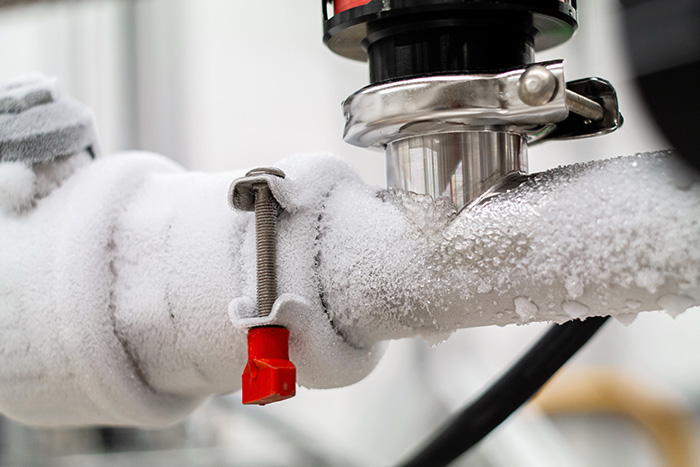Actions to Take If My AC Pipe Is Frozen - Immediate Solutions for Thawing
Actions to Take If My AC Pipe Is Frozen - Immediate Solutions for Thawing
Blog Article
In this article down the page you can discover a good deal of outstanding tips involving How can I fix an air conditioner’s frozen pipe?.

Intro
Uncovering that your AC pipeline is frozen can be concerning, specifically throughout hot summertime when you rely upon your ac system one of the most. Comprehending what to do in such a scenario is essential to stop further damages to your air conditioning system and guarantee your convenience indoors.
Understanding the Causes
A number of elements can add to the freezing of an air conditioning pipeline. Recognizing these reasons can aid you address the concern properly.
Absence of Airflow
One usual cause of a frozen air conditioner pipe is inadequate air flow. When the air flow over the evaporator coil is limited, it can create the coil to drop below freezing temperature, resulting in ice formation on the pipeline.
Low Refrigerant Levels
Inadequate refrigerant levels in your air conditioning system can likewise lead to a frozen pipe. Reduced cooling agent levels can cause the pressure in the system to drop, causing the cold of moisture on the evaporator coil.
Winter Conditions
In cooler climates, freezing temperatures outside can contribute to the freezing of AC pipes. If your air conditioning system is not properly insulated or if there are leaks in the ductwork, chilly air can penetrate the system, creating the pipeline to ice up.
Dirty Air Filters
Filthy or clogged up air filters can restrict air movement in your air conditioning system, resulting in various issues, including an icy pipe. It's vital to replace or cleanse your air filters frequently to make certain proper air flow and protect against ice accumulation.
Indicators of a Frozen AC Pipe
Acknowledging the signs of a frozen air conditioner pipeline is critical for timely action.
Reduced Airflow
If you see a substantial reduction in air flow from your vents, it could suggest a frozen pipeline.
Ice Buildup on the Pipe
Noticeable ice build-up on the cooling agent line or the evaporator coil is a clear sign of a frozen air conditioner pipeline.
Odd Sounds from the Unit
Uncommon noises, such as hissing or gurgling, originating from your a/c system can indicate that there's ice present on the pipeline.
Immediate Actions to Take
When faced with a frozen air conditioning pipeline, it's necessary to act promptly to avoid additional damage to your cooling system.
Turning off the a/c
The initial step is to switch off your air conditioning system to avoid the system from running and worsening the concern.
Looking for Blockages
Inspect the area around the indoor unit for any type of obstructions that might be blocking air flow, such as furniture or curtains.
Thawing the Pipe
You can use mild techniques like positioning towels taken in cozy water around the icy pipeline to aid thaw it gradually.
Safety nets
Taking safety nets can aid prevent future events of a frozen air conditioner pipeline.
Routine Maintenance Checks
Schedule normal upkeep contact an expert HVAC specialist to make certain that your a/c system is running efficiently.
Altering Air Filters
On a regular basis replace or clean your air filters to prevent air flow limitations and keep optimal performance.
Insulating Exposed Pipes
If your AC pipes are subjected to chilly temperature levels, take into consideration protecting them to stop cold during winter months.
Seeking Professional Help
If DIY approaches stop working to resolve the concern or if you're unsure regarding how to proceed, it's ideal to look for help from a qualified HVAC specialist.
When DIY Methods Fail
If your attempts to thaw the pipe or address various other problems are not successful, it's time to contact a professional.
Value of Hiring a Professional HVAC Technician
A certified HVAC service technician has the competence and devices needed to identify and fix concerns with your AC system securely and efficiently.
Verdict
Taking care of an icy a/c pipeline can be a frustrating experience, however understanding how to respond can help reduce damages and bring back convenience to your home. By recognizing the reasons, recognizing the indicators, and taking timely action, you can efficiently deal with the issue and prevent future incidents.
What to Do If Your AC Line Is Frozen
Make Sure All Supply and Return Air Vents Are Open
If you notice problems with airflow, the first thing you should do is check your supply and return vents. Supply vents distribute clean, conditioned air throughout your home. As this air becomes stale, it’s pulled into the return vent, where it’s reconditioned before being sent back out through the supply vent.
When these vents are closed, air won’t flow in the home. Before examining your AC, check the vents in every room and ensure they’re all open.
Check for a Dirty Air Filter
Another possible cause of limited airflow is a dirty air filter. Your air conditioner’s filters catch elements you don’t want to breathe in, such as dirt and dust. Over time, filters can become clogged, ultimately blocking air from flowing in and out. The lack of airflow can then cause the entire coil to freeze and will completely restrict any air from moving through it. The AC may need to be powered off for one to two days to allow the coil to thaw after replacing the filter to allow proper functioning of the unit. This debris can also accumulate on your AC’s evaporator coil, requiring a more serious repair. In general, air filters should be cleaned regularly (about every two weeks).
Assess Your Outdoor Unit
In addition to checking your AC, assessing the outdoor unit is a good idea. Also known as the condensing unit, it works with your interior unit to release heat outside. An issue with the outdoor unit can result in rising internal temperatures.
Overgrown Shrubs or Clogged Leaves
From leaves and twigs to shrubs and debris, there’s no shortage of outdoor elements that can accumulate around your condensing unit. When these elements get lodged inside the unit, they can block airflow. Fortunately, removing the blockage can solve the problem.
Sounds of a Broken Fan
Shrubs and leaves aren’t the only things that can impede your outdoor unit’s airflow. If the fan is broken, the unit won’t be able to properly get rid of heat — which means the internal temperature won’t go down. First, make sure the fan is spinning. If it is, check for the following sounds of a broken fan:
Buzzing Rattling Screeching Hissing Clicking Preventative Measures
Nobody wants to deal with a frozen AC line. In addition to causing problems with your air conditioner, they require professional repairs. On the bright side, there are preventative measures you can take to help ensure this issue doesn’t arise in the first place.
https://www.coopergreenteam.com/blog/what-to-do-if-ac-line-frozen

We had been introduced to that report about Air Conditioner Frozen? How To Fix your Frozen AC Line from someone on another site. Don't hesitate to set aside a second to share this article if you enjoyed reading it. Kudos for your time. Please pay a visit to our blog back soon.
Call Today Report this page